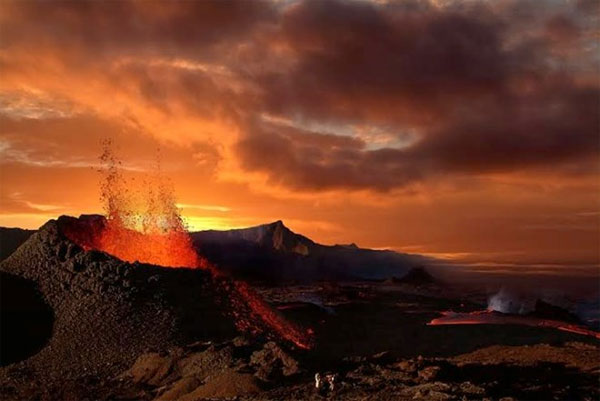With streams of hot lava flowing down and sparks in the dust clouds, the sight of an erupting volcano is both terrifying and awe-inspiring. So what would happen if all the volcanoes on Earth erupted at the same time?

Scientists estimate there are about 1,500 active volcanoes on Earth, not including the uncounted number of submarine volcanoes. Every day, 10-20 volcanoes erupt on Earth. However, scientists believe that the likelihood of all these volcanoes erupting at the same time is very low, to the point of being almost impossible.
But assuming this happens, what chance does Earth have of surviving? Parv Sethi, a geologist at Radford University, Virginia, said the answer is no.
The eruption of terrestrial volcanoes alone is enough to trigger serious environmental impacts in a domino effect, with many times the power of a nuclear bomb. Although molten lava will kill people living near volcanoes first, this number pales in comparison to those killed by climate change.

Volcano erupts.
Sethi predicted that if all the volcanoes on Earth erupted at the same time, a thick blanket of ash would cover the Earth like a blanket and block all light from the Sun.
“The Earth will be completely plunged into darkness. Without light, plants will not be able to photosynthesize and grow, crops will fail and temperatures will drop sharply,” the scientist said . This ash screen will even cover the Earth within 10 years.
In fact, not all volcanoes are capable of producing large amounts of ash, for example the volcano in Hawaii only produces lava. However, the US Geological Institute’s list of 1,500 active volcanoes on Earth includes the names of super volcanoes that could just erupt and engulf the entire United States in a thin layer of ash.
Even if they survive the ash, another problem arises: acid rain. Emissions from volcanic eruptions contain a lot of hydrochloric acid, hydrogen fluorine, hydrogen sulfur and sulfur dioxide in large concentrations in the atmosphere, creating acid rain, polluting groundwater and ocean surfaces.

Acidic sea water will cause corals and other marine organisms to die en masse, destroying the ocean food chain and leading to a mass extinction event, as happened in Earth’s past at the end of the Permian period. , Triad and Cretaceous periods.
In addition, the release of ash and gas into the atmosphere will block sunlight and cause the Earth’s temperature to decrease significantly, even if only for a short time.
Although volcanic eruptions also produce carbon dioxide that can increase the Earth’s heat, according to scientist Sethi, the amount of carbon dioxide produced from 1,500 volcanoes erupting at the same time is so large that it causes the atmosphere to freeze. poisoning and the Earth’s temperature rising too high, absolutely not a suitable living environment for humans.
Faced with this scenario of simultaneous volcanic eruptions, Sethi believes that only extremophiles – extremely resistant bacteria – can survive. These are organic organisms that live in extremely harsh environments such as underground hot springs or deep under the sea, where they are safe from destruction on the ground.
Another science fiction scenario is also thought of, which is that only a few people will survive by taking refuge in underground bunkers built by the government and wealthy people, waiting for the disaster to pass. or leave Earth to fly into space.
“At that time, the luckiest people were the ones who died,” Sethi commented.





